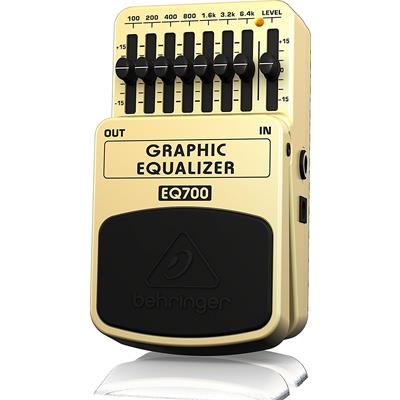| Build Quality: |  |
| Hardware: |  |
| Electronics: |  |
| Sound: |  |
| Value: |  |
| Average: |  |

Pros:
- Adds presence to your sound
- Extremely affordable
- Sensitive frequency adjustment
Cons:
- Not great build quality
- Might develop some noise
My affection towards music grew stronger when I was in college. My roommate had a guitar and he would practice every single day. I had admired this instrument from the very childhood and learnt playing it when I was still a kid. But after years of being broken up, me and my guitar grew apart. Since my annoying (in the best way possible) roommate would not stop performing, I decided to show the light of day to my beloved guitar, recall my skills and learn some new techniques. After years of practicing together, we started collecting money to buy cool gear (a.k.a. every single pedal on earth) and since we were students, we still had to stay within limited budget. It might be surprising but the very first stompbox we purchased was an equalizer. To be honest, it was not the best and at some point made us skeptical about this effect. But later on, when I was older and my playing could actually be called playing, I decided to revisit the world of equalizers and try something new. That is when I found Behringer EQ700 Graphic Equalizer. It quickly became my favorite in its price range and I do still utilize it for certain applications. If you are looking for an equalizer that will not break the bank, just keep on reading!
Features
Before moving any further, I want to underline one thing: this is the case when you get what you pay for. What I mean is that this bad boy is amazing for its price, but if you compared it to a 200 dollar unit, it would not be as good as its higher end rival (and that is completely natural). Let’s be real, it would be infeasible to create a perfect unit that would do it all at such a small price. Now that I have this off my chest, we can continue our journey into the features of this bad boy.
The chassis of Behringer EQ700 Graphic Equalizer is made out of hard plastic (not the best but who is complaining?) that will last you for a long time if you take care of it (which you should do even with metal enclosures). It is equipped with analog circuitry that is the main contributor to the capabilities of the pedal. This fella has 7 bands that cover a wide range, enabling you to shape various frequencies with ease. It is configured in light yellow color palette that is combined with black patterns. Whether you like its design or not is completely up to you, but for me it looks pretty good. Typically, Behringer EQ700 Graphic Equalizer needs a single 9V battery or a power supply in order to operate. It has a LED that illuminates once the unit is activated, showing you what is happening even in poorly lit places. Of course it has an input and an output for connecting it to your instrument and amplifier, or the rest of the chain.
Controls
It will not be hard to guess what the control section looks like if you remember that EQ700 Graphic Equalizer is a graphic equalizer (duh!). For this reason, its layout is comprised with sliders that move on vertical bands. You only need to shift them up or down in order to hear sonic differences. If I am being honest, I think that such control panel is way easier to navigate through even though it takes a bit more time. The fact that you can see where each frequency is and what are its settings helps you understand your sound better and, thus, modify it professionally. After all, equalizer can destroy your tone just as easily as it can improve it.
Going to the control panel itself, we have 8 sliders in total. First seven are utilized for cutting or boosting specific frequencies with ±15dB. In particular, you can modify frequencies at 100, 200, 400, 800, 1.6K, 3.2K, 6.4K. The last slider (i.e. Level) acts as a volume control and allows you to attenuate or accentuate the level of the affected signal. This also enables you to shape the volume of an uneven amplifier. It all depends on the issues that you want to eliminate with the help of this unit. Regardless, it is quite clear that Behringer EQ700 Graphic Equalizer can be tweaked in no time (especially if you know what to do with such devices).
Behringer EQ700 Sound
The real test for affordable pedals is usually their sound. And more often than not they pass it with ease. Sure, some purists and picky players will find certain flaws, but if we are talking about overall sonic quality, it is rather decent. The same thing goes for Behringer EQ700 Graphic Equalizer. It can easily add some warmth to your cold riffs or brighten up the whole performance with a subtle boost of higher frequencies. You can also attenuate the mid-range completely and explore the appraised “scooped” mids. It will not add an unusual or artificial feeling to your tone, which is a huge perk of the unit. EQ700 Graphic Equalizer does operate without hissing, but if you do not choose the settings carefully, it might develop some noise. Other than that, this pedal is a perfect option for bedroom practices and rehearsals in general. If we are being honest, you do not really need pricey parametric equalizers when the walls are your only audience. It could be an amazing starting point for those who are just starting to explore the capabilities of equalizers and do not want to spend big money on something they are not sure about.
Conclusion
The final verdict? Nothing that will surprise you. Behringer EQ700 Graphic Equalizer is an amazing pedal for the price. It is so cheap that you do not have the right to complain about anything. It will become your favorite tool to practice with and will help you get the grip of equalizers in general. Just listen to demos to fully understand what the scope of its operation is and make the decision accordingly. Good luck!
Click here to view more from 10 Best EQ Pedals.






